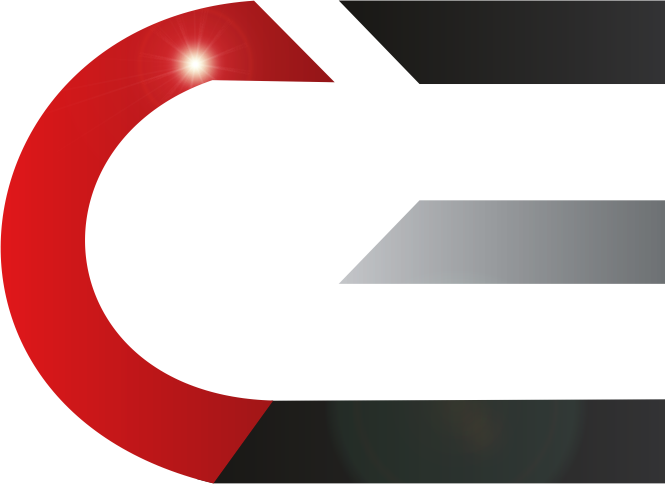Introduction: How to Become a Pilot in India
Pilots are highly experienced, talented, and licensed individuals who must complete a variety of training courses in order to operate an airplane or a helicopter. They are in charge of flying a variety of aircraft, including passenger planes, cargo planes, and postal planes, and are also in charge of maintaining an aircraft’s internal mechanics and developing a flight plan while keeping numerous elements such as aircraft performance, altitude, and weather forecasts in mind.
One study says there are 17,726 pilots in India, with 2,764 of them being women.
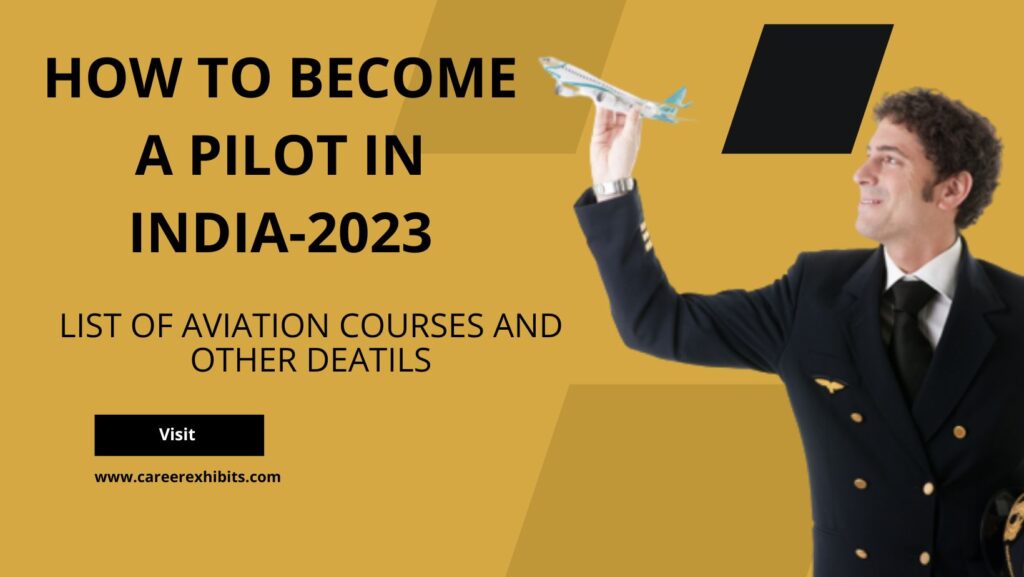
In India, there are precise qualifications needed to become a pilot in order to have a successful career. To enroll in undergraduate and graduate aviation programs, students must have completed the required math, physics, and chemistry courses. Some of the best Undergraduate and Postgraduate degrees for becoming a Pilot after the 12th grade include B.Sc. Aviation, BBA Aviation Management, MBA Aviation Management, B.E. Aeronautical Engineering, and others. Some of the greatest aviation schools in the nation, including NIMS University, Indira Gandhi Rashtriya Uran Academy, AIMS Institute, Kristu Jayanti College, and others, offer these courses.
How to Become a Pilot in India: Course Highlights
The following are the most important aspects of how to become a pilot:
| Entrance Exam | NDA exam |
| Eligibility | 10 + 2 in Science (MPC)/Commerce |
| License | A Commercial Pilot License (CPL) |
| Salary Range (INR) | 3.50 LPA- 5 LPA |
| Pilot Training Course Fees | 15 LPA – 20 LPA |
| Pilot Classifications | Commercial pilot, Airline pilot, Fighter pilot, etc. |
| Top Pilot schools in India | Indira Gandhi Rashtriya Uran Academy, Bombay Flying Club, National Flying Training Institute, etc. |
Types of Pilots
There are many sorts of pilots based on the streams and disciplines that applicants pursue. Mentioned below are the types of pilots:
| Different type of Pilots | |
| Airline Transport Pilots | These are the pilots who fly commercial jets for private airlines and transport customers. |
| Private Pilots | Those who can afford a private aircraft like to have access to private pilots at all times. |
| Sports Pilots | They must fly below 10,000 feet and mostly within a specific range. |
| Flight instructors | They work for a training company and are in charge of teaching other aspiring pilots how to fly. |
| Air Force Pilots | Trained by the country’s air force, they are professionals in flying armed planes for the defense ministry. |
How to Become a Pilot in India?
To become a pilot in India, specific processes and preparations must be made beginning in elementary school. The following are the actions that may be taken to become a Pilot at various levels:
How to Become a Pilot in India After 12th?
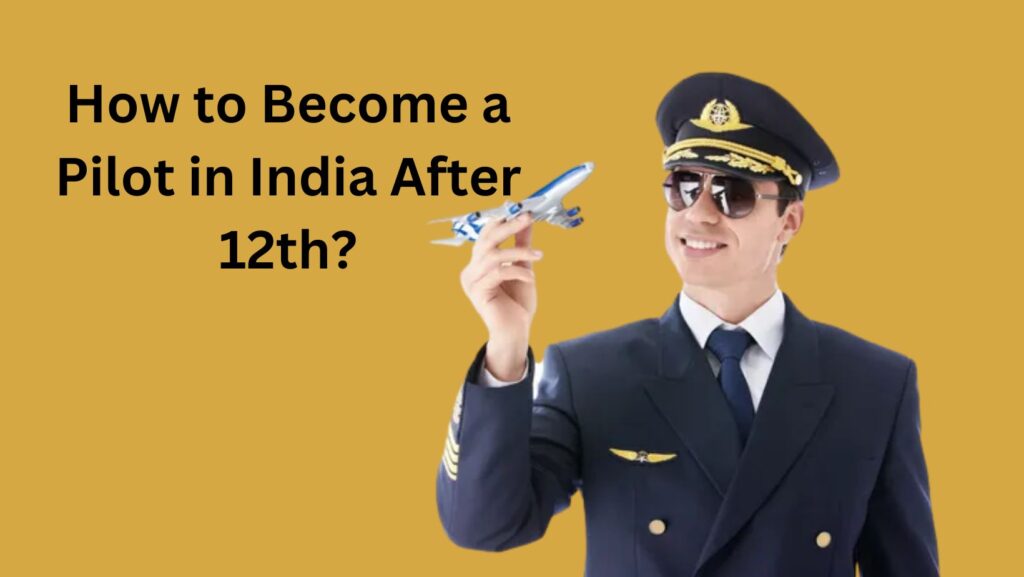
After passing Class 12, you must do the following steps in order to become a pilot:
- After graduating from high school, those who want to become pilots can enroll in a variety of undergraduate aviation programs, such as the BSc Aviation program.
- Students who want to be pilots may enroll in Postgraduate Aviation programs like MSc Aviation Courses. They must also pass the Pilot Licensing Exams in order to be qualified to become a pilot.
Students who want to become Pilots After 12th grade, students must adhere to a set of steps and practices that are essential for a quick and simple journey through the process. The steps for becoming a pilot in India after 12th grade are listed below:
| Steps | Details | |
| Step 1 | Select a Flight Training Institute | This strategy would not only guarantee that the students got a thorough education in the subject, but it would also provide a solid foundation for their personal growth. Among the top aviation schools in India are the National Flying Training Institute, Indira Gandhi Rashtriya Uran Academy, Rajiv Gandhi Academy of Aviation Technology, Bombay Flying Club, and others. |
| Step 2 | Gain Experience | After completing high school, gaining experience is the second most crucial stage in becoming a pilot. To do this, students must accrue flying hours. Commercial pilots are required to have 250 hours of flight time, whereas airline pilots are required to have 1,500.Formal schooling will provide a basic education, but those who want more in-depth knowledge and experience may go for a private tutor or even enlist in the military. The Private Pilot License (PPL), Certified Flight Instructor (CFL), Commercial Pilot License (CPL), Commercial Multi-Engine Land (CMEL), and other top licenses are available to aspiring pilots. |
| Step 3 | Finish All Training and Examinations | Students must have experience as a Pilot and Co-Pilot in a regional airline and pass all aptitude and psychological tests. After gaining enough experience, pilots can apply for larger airlines and more flying time. |
| Step 4 | Airline Pilot Experience | Seniority and experience are the only factors that determine whether a pilot becomes a captain. Additional FAA written and practical exams must be passed by pilots who want additional flight ratings. Pilots can keep researching and examining how the industry is changing. To assist pilots in honing their abilities and advancing their careers, the Aircraft Owners and Pilots Association (AOPA) and the International Federation of Airline Pilots Associations (IFALPA) offer educational seminars and webcasts. |
Eligibility of Pilot Course after 12th
In India, eligibility to become a pilot is determined by two factors: physical fitness and educational qualifications. In order to become a pilot, each candidate must meet certain qualifying conditions. Male and female pilots have distinct physical needs.
The physical qualifying standards for both female and male flyers are listed below:
Physical Requirements of Pilot Course (Male Candidate)
The list of physical qualifications required to become a pilot after the 12th grade is given below:
| Specifications | Details |
| Height | 163.5 cms |
| Vision | 6/6 in one eye and 6/9 in the other |
| Leg Length | 99 cms – 120 cms |
| Thigh Length | 64 cms |
| Sitting Height | 81.5 cms – 96 cms |
| Candidates must not be colorblind or suffer from night blindness. | |
Physical Requirements of Pilot Course (Female Candidate)
The list of physical qualifications required to become a pilot after the 12th grade is given below-
| Specifications | Details |
| Height | 162.5 cms |
| Vision | 6/6 in one eye and 6/9 in the other |
| Leg Length | 99 cms – 120 cms |
| Thigh Length | 64 cms |
| Sitting Height | 81.5 cms – 96 cms |
| Candidates must not be colorblind or suffer from night blindness. | |
| The DGCA has special qualifications for becoming a commercial pilot after the 12th. | |
How to become a Pilot: Educational Requirements
The educational requirements for students desiring to become pilots after the 12th grade are provided below-
- Candidates interested in becoming pilots should have a Bachelor’s degree in Aeronautical Engineering, Aircraft Operations, or a similar field.
- Students from any other science stream can apply for this course; but, in order to work in this field, they must first complete an aviation degree.
- Every pilot must have a pilot transformation certificate and instrument rating certification. Students must get a commercial pilot license.
- A minimum of 250 hours of ground training is required for aspiring pilots to get a pilot’s license.
- Aside from flying technical capabilities, students must also possess personal and emotional attributes in order to become pilots.
Pilot Course Eligibility Criteria
To enroll in any of the aviation courses, one must fulfill the school or academy’s qualification requirements. To become a pilot in India, you must have completed the 12th grade and have the following qualifications:
- The candidate must be at least 17 years old to begin training.
- One must have a minimum of 50% in their 10+2, which may vary depending on the institute.
- One must have completed MPC subjects (Mathematics, Physics, and Chemistry) as well as English at an intermediate level.
- If a person is not a science student, then he/she can take the needed topics through the National Institute of Open Schooling or as a private candidate through the corresponding state board.
- A medical certificate from the proper authorities is required.
Pilot Course Entrance Exams Accepted
Some of the most important entrance exams that must be passed in order to become a pilot are listed below-
- AFCAT (Air Force Common Admission Test)
| Specifications | Details |
| AFCAT Full-Form | Air Force Common Admission Test |
| Registration Date | To be Notified |
| Exam Date | To be Notified |
| Mode of AFCAT Exam | Online |
| Total no. of Questions | 100 |
| Marks | 3 marks for each correct answer (-1 negative marking) |
| Duration | 120 minutes |
| Total Marks | 300 |
- NDA (Union Public Service Commission National Defence Academy and Naval Academy Exam)
| Specifications | Details |
| NDA Full-Form | Union Public Service Commission National Defence Academy and Naval Academy Exam |
| Registration Date | December 2022 |
| Exam Date | To be Notified |
| Mode of NDA Exam | Offline |
| Total no. of Questions | 270 |
| Duration | 5 hours |
| Total Marks | 900 |
- CDSE (Union Public Service Commission Combined Defence Services)
| Specifications | Details |
| CDSE Full-Form | Union Public Service Commission Combined Defence Services |
| Registration Date | October 2022 |
| Exam Date | To be Notified |
| Mode of CDSE Exam | Paper-Based |
| Total no. of Questions | English – 120 General Knowledge – 120 Elementary Math – 100 |
| Marks | 1 marks each |
| Duration | 6 hours |
| Total Marks | 300 |
Skills required to Become a Pilot in India
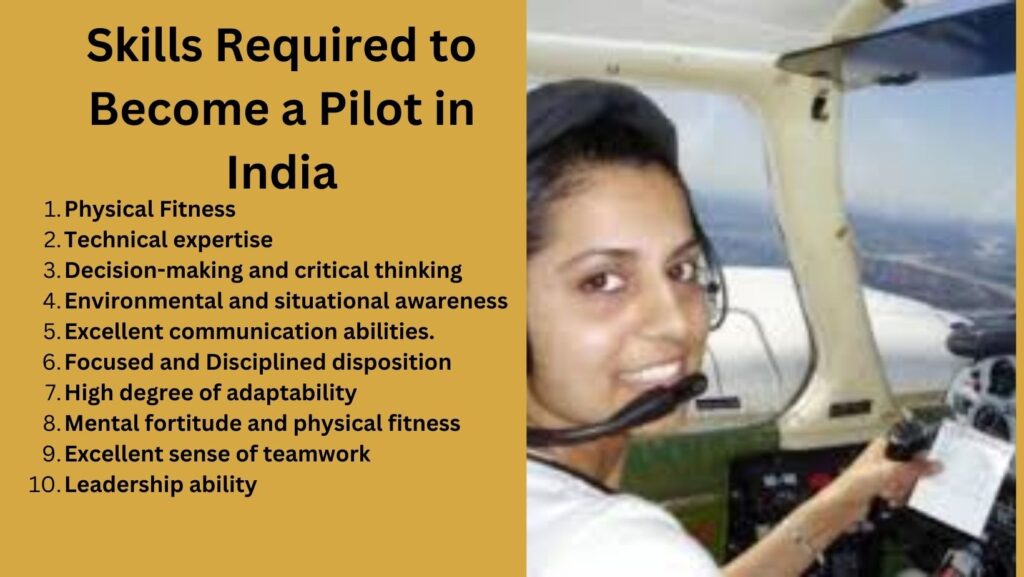
Aside from academic knowledge, students must have the following skills to be good pilots-
- Physical Fitness
- Technical expertise
- Decision-making and critical thinking
- Environmental and situational awareness
- Excellent communication abilities.
- A very focused and disciplined disposition
- High degree of adaptability
- Mental fortitude and physical fitness
- Excellent sense of teamwork
- Leadership ability
License to Become a Pilot

The following is the list of license to become a pilot in India-
- Private Pilot License (PPL): A Private Pilot License allows a person to fly small jets and private planes. They are unable to fly commercial aircraft. Millionaires or government agencies employ them to fly personal planes.
- Certified Flight Instructor (CFL): A CFL license allows a person to give flying lessons in flight training institutes. They pass on their expertise to subsequent generations.
- Commercial Pilot License (CPL): After the 12th grade, the most in-demand license to become a pilot is the Commercial Pilot License (CPL). Individuals with a Commercial Pilot License may operate large airline commercial jets.
Top Pilot Training Institutes in India
Mentioned below are some of India’s most famous colleges for pilot training and education along with average fees of the colleges-
| Flight Training Colleges | Average Annual Fees (INR) |
| Indira Gandhi Rashtriya Uran Academy | Rs. 42 lakh |
| The Bombay Flying Club (BFC) | Rs. 10 lakh |
| National Flight Training Institute | Rs. 50.05 lakh |
| Government Aviation Training Institute | Rs. 55 lakh |
| Indian Institute of Engineering and Aeronautics | Rs. 12 lakh |
| Indian Institute of Aeronautics | Rs. 1.70 lakh |
| Wingsss College of Aviation and technology | Rs. 23 lakh |
| Hindustan Aviation Academy | Rs. 4 lakh |
| Ahmedabad Aviation and Aeronautics | Rs. 20 lakh |
How to Become a Pilot in India: List of Aviation Courses
- Aviation UG Courses List
| Courses | Annual Fees (INR) |
| B.Sc. Aviation | Rs. 65k |
| BBA Aviation Operations | Rs. 78k |
| BBA Airport Management | Rs. 1 lakh |
| B.Sc. Aeronautical Science | Rs. 90k |
| BMS in Aviation Management | Rs. 80k |
| B.E. in Aeronautical Engineering | Rs. 3 lakh |
| B.E. Aerospace Engineering | Rs. 3.75 lakh |
| B.Tech Aeronautical Engineering | Rs. 2 lakh |
| B.Tech Avionics Engineering | Rs. 90k |
- Aviation PG Courses List
| Courses | Annual Fees (INR) |
| M.Sc. Aerospace Engineering | Rs. 2 lakh |
| MBA in Aviation | Rs. 10.50 lakh |
| M.Sc. in Aviation | Rs. 6 lakh |
| M.Sc. Aeronautical Science | Rs. 7.35 lakh |
| M.E. Aeronautical Engineering | Rs. 8 lakh |
| M.Tech. Aeronautical Engineering | Rs. 9.90 lakh |
| M.Tech. Aerospace Engineering | Rs. 2 lakh |
| M.E. Aerospace Engineering | Rs. 5.90 lakh |
| M.Tech. Avionics Engineering | Rs. 8.75 lakh |
- List of Certification to Become Pilot
| Certifications | Annual Fees (INR) |
| Aviation: Airline Customer | Rs. 36k |
| Cabin Crew Training | Rs. 31k |
| Service Course: Aviation Industry | Rs. 36k |
| Aviation: Aircraft Ground Support Equipment | Rs. 36k |
| Security Operations, Processes & Strategies in Aviation Aviation 101 – Embry-Riddle Aeronautical University Sustainable Aviation: The Route to Climate-Neutral Aviation | Rs. 36k Free Online Course Free Online Course |
Public and Private Sector-Wise Salary Placement of Pilot
| Name of the sector | Average Annual Salary (INR) |
| Government (IAF) | Rs. 5 – 8 lakh |
| Private (Commercial) | Rs. 18 – 60 lakh |
Specialization Sector-Wise Salary of Pilot In India
| Types of Pilots | Average Annual Salary (INR) |
| Private Pilots | Rs. 1.5 – 2 lakh |
| Flight Instructors | Rs. 3.2 lakh |
| Commercial Pilots | Rs. 24 lakh |
| Airline transport Pilots | Rs. 11 lakh |
Experience-Wise Salary Salary of Pilot in India
| Experience (in years) | Average Annual Salary (INR) |
| < 2 | Rs. 17.50 lakh |
| 2 – 5 | Rs. 20 lakh |
| 5 – 10 | Rs. 45 lakh |
| 10 – 20 | Rs. 70 lakh |
| 20 + | up to Rs. 90 lakh |
Few Top Recruiting Clients of Pilot
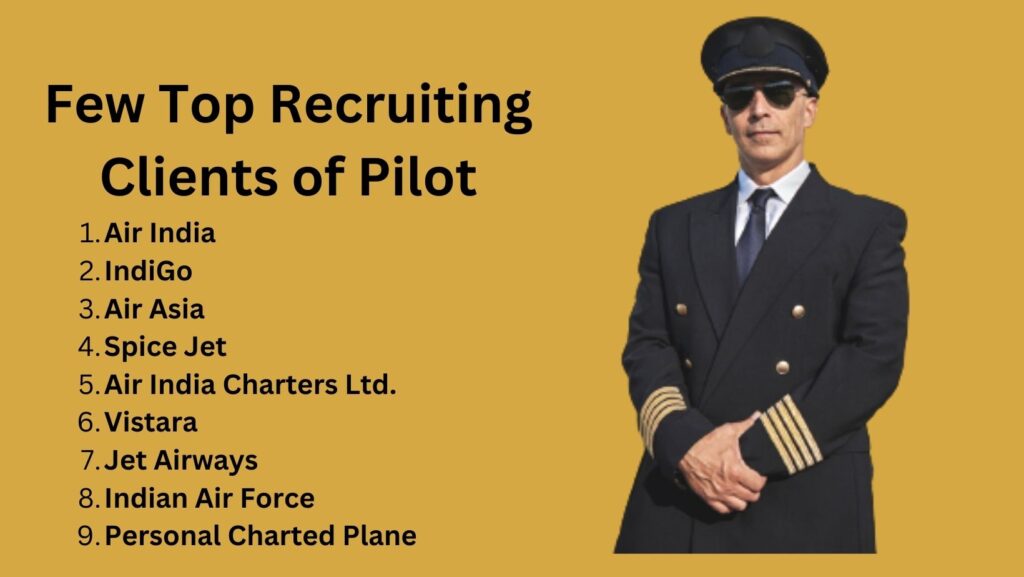
Some of the largest clients in this field include-
- Air India
- IndiGo
- Air Asia
- Spice Jet
- Air India Charters Ltd.
- Vistara
- Jet Airways
- Indian Air Force
- Personal Charted Plane
Comparison between Civil Aviation and Armed Force Aviation
- Civil Aviation: To become a Pilot in Civil Aviation, commonly known as a Commercial Pilot, aspiring candidates must get several commercial pilot certificates from various permitted agencies, according to India’s Directorate of General Civil Aviation.
- Indian Defense Force: To become a pilot for the Indian Defense Force, one must first pass numerous Entrance Exams, after which they must undertake rigorous training for three years at the National Defense Academy before joining the Indian Air Force (IAF). Aside from the multiple-aptitude tests, candidates must also pass medical exams in which their height, weight, and eyesight are meticulously assessed.
Top 5 Advantages of a Pilot Career
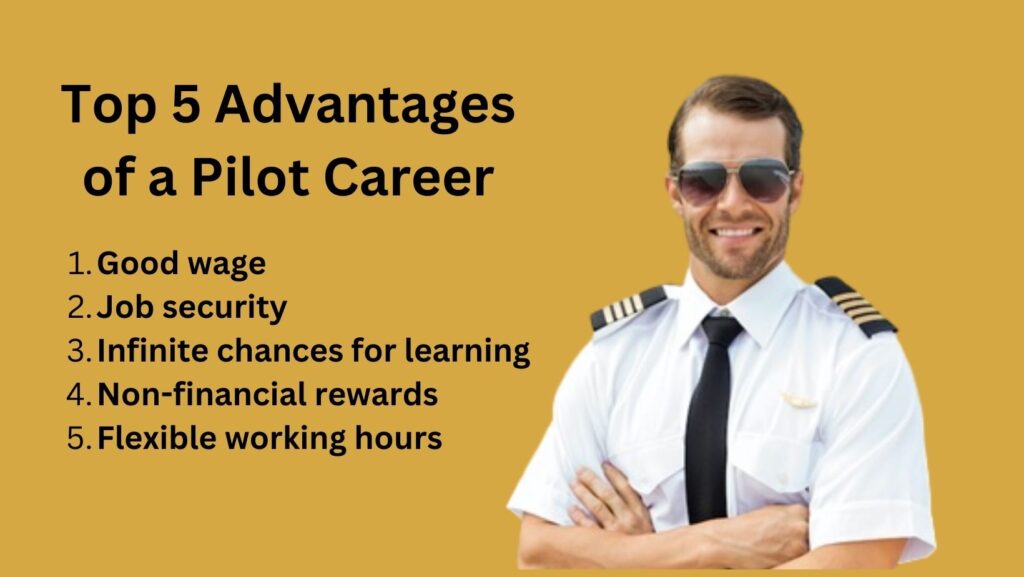
The following are some of the advantages of how to become a pilot in India-
- Good wage: Pilots receive a good wage that enables them to live comfortably and invest. With a stable pay scale as a pilot, one can also travel for free to places they have never been.
- Job security: As demand for pilots rises, they are in high demand.
- Infinite chances for learning: As the aviation industry continues to grow, there is a lot for pilots to learn. You can increase your multitasking skills by taking this opportunity.
- Non-financial rewards: Include free housing, meals, and other perks for pilots as well as travel savings for friends and family. Pilots also receive a number of health benefits.
- Flexible working hours: Pilots can travel in accordance with their needs and preferences because of their flexible work schedules.
Conclusion
Becoming a pilot in India requires dedication, perseverance, and a strong commitment to safety. It is a challenging yet rewarding career path that offers exciting opportunities and a chance to explore the world from a unique perspective. To embark on this journey, aspiring pilots need to follow a systematic approach that includes meeting the necessary prerequisites, obtaining the required education and licenses, and gaining practical flying experience.
The process starts with completing the 10+2 education level with science subjects and obtaining a Class 1 Medical Certificate. Aspiring pilots then have the option to join a flying school or pursue a bachelor’s degree in aviation. Flying schools provide the necessary ground and flight training required to obtain a Private Pilot License (PPL) and a Commercial Pilot License (CPL).
After acquiring the CPL, aspiring pilots need to accumulate a minimum number of flight hours to be eligible for Airline Transport Pilot License (ATPL) or an Aircraft Type Rating (ATR) based on their career goals. This can be achieved by working as a flight instructor, charter pilot, or gaining experience in other flying roles. Additionally, candidates must pass written exams, flight checks, and meet other criteria set by the Directorate General of Civil Aviation (DGCA).
It is crucial for aspiring pilots to remain updated with the latest aviation regulations, technological advancements, and safety procedures. Continuous learning and professional development are essential to succeed in this dynamic field.
Becoming a pilot also demands certain personal qualities such as excellent communication skills, problem-solving abilities, quick decision-making, and the ability to remain calm under pressure. These skills are essential for ensuring the safety of passengers, crew, and the aircraft itself.
While the journey to becoming a pilot in India may seem challenging, the rewards are well worth the effort. Pilots have the opportunity to travel the world, experience different cultures, and enjoy a fulfilling career with competitive salaries. Moreover, the aviation industry in India is growing rapidly, offering numerous employment opportunities for qualified pilots.
It is important to remember that the path to becoming a pilot requires determination, resilience, and a passion for aviation. By following the necessary steps, gaining experience, and remaining committed to ongoing learning, individuals can achieve their dream of becoming a pilot in India and soar to new heights in their career.
Can I become pilot after 23?
Yes, it is possible to become a pilot after the age of 23. The minimum age requirement to obtain a Commercial Pilot License (CPL) in India is 18 years. However, the process of becoming a pilot involves completing the necessary education, flight training, and accumulating flight hours. This can take several years to accomplish, and many individuals pursue their pilot training after the age of 23. It’s important to note that the aviation industry values skills, qualifications, and experience, regardless of the age at which they are acquired. So, if you are passionate about becoming a pilot, age should not be a limiting factor in pursuing your dream.
What can I do after 12th to become a pilot?
Choose Science Stream: Opt for Science (Physics, Chemistry, and Mathematics) in your 12th grade education. It is essential for a career in aviation.
Obtain Class 1 Medical Certificate: Undergo a thorough medical examination and obtain a Class 1 Medical Certificate from a designated medical examiner to ensure you meet the medical requirements for pilots.
Join a Flying School or Pursue Aviation Degree: You have two options. You can either join a flying school that provides ground and flight training to obtain licenses or pursue a bachelor’s degree in aviation from a recognized institute.
Private Pilot License (PPL): Complete the necessary training and clear the written exams to obtain a Private Pilot License (PPL). This allows you to fly as a recreational pilot.
Commercial Pilot License (CPL): After acquiring the PPL, continue flight training and accumulate the required flying hours to qualify for a Commercial Pilot License (CPL). This license allows you to fly for commercial airlines.
Gain Experience and Ratings: To enhance your employability, gain experience by working as a flight instructor, charter pilot, or in other flying roles. You may also need to obtain additional ratings and endorsements depending on your career goals.
Clear DGCA Exams and Checks: Pass the written exams and flight checks conducted by the Directorate General of Civil Aviation (DGCA), the regulatory body for aviation in India.
By following these steps and meeting the necessary requirements, you can pursue your dream of becoming a pilot after completing 12th grade. It is essential to stay committed, work hard, and continuously update your skills to succeed in the aviation industry.
Which exam is given for pilot?
Written Exams: Aspiring pilots need to pass written exams on subjects such as aviation meteorology, air navigation, aircraft systems, air regulations, and more. These exams test the theoretical knowledge required for safe and efficient flying.
Flight Checks: Candidates are evaluated through flight checks conducted by DGCA examiners. These checks assess their flying skills, decision-making abilities, adherence to safety procedures, and overall competency in operating an aircraft.
Clearing both the written exams and flight checks is necessary to obtain various pilot licenses, including the Private Pilot License (PPL), Commercial Pilot License (CPL), Airline Transport Pilot License (ATPL), and specific aircraft type ratings.
It is important for aspiring pilots to prepare thoroughly for these exams by studying the relevant subjects, gaining practical experience, and staying updated with the latest aviation regulations and procedures.
Which age is best for pilot?
The most important factors for becoming a pilot are meeting the necessary requirements, including education, flight training, and acquiring the required licenses. Additionally, having the right skills, dedication, and a passion for aviation are essential regardless of age.
It’s worth noting that airlines may have their own age requirements or preferences when hiring pilots, but there are opportunities for individuals of different age groups in the aviation industry. Ultimately, the decision to become a pilot should be based on personal goals, commitment, and readiness to pursue a challenging yet rewarding career in aviation.
